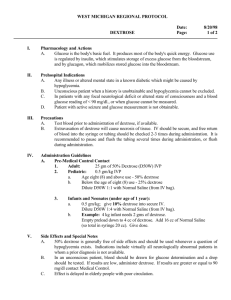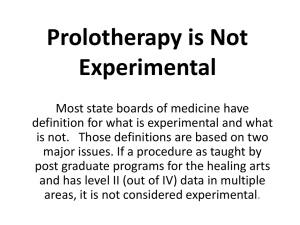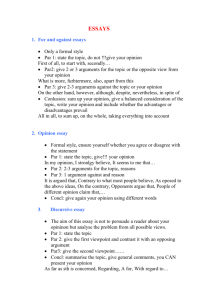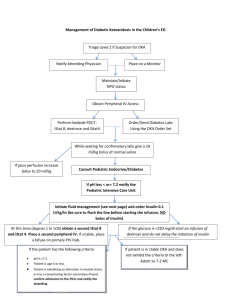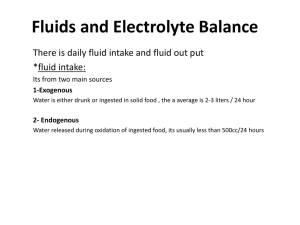Hinz, KLG, Killer Carbs: Effects of 50% Dextrose Treatment on
advertisement
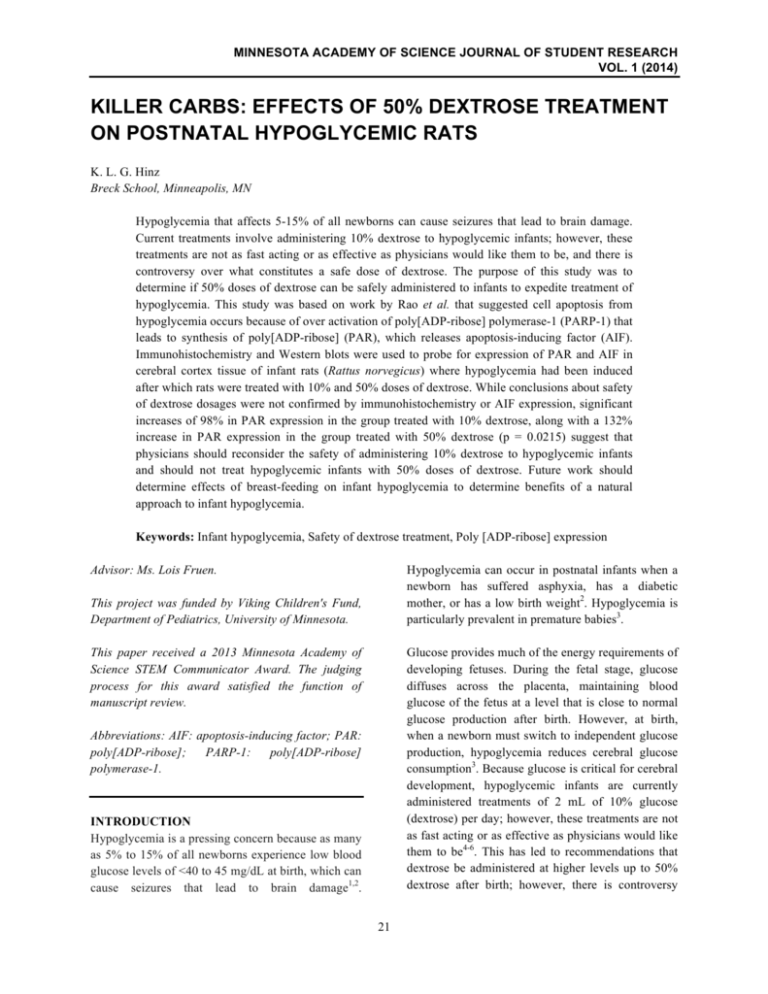
MINNESOTA ACADEMY OF SCIENCE JOURNAL OF STUDENT RESEARCH VOL. 1 (2014) KILLER CARBS: EFFECTS OF 50% DEXTROSE TREATMENT ON POSTNATAL HYPOGLYCEMIC RATS K. L. G. Hinz Breck School, Minneapolis, MN Hypoglycemia that affects 5-15% of all newborns can cause seizures that lead to brain damage. Current treatments involve administering 10% dextrose to hypoglycemic infants; however, these treatments are not as fast acting or as effective as physicians would like them to be, and there is controversy over what constitutes a safe dose of dextrose. The purpose of this study was to determine if 50% doses of dextrose can be safely administered to infants to expedite treatment of hypoglycemia. This study was based on work by Rao et al. that suggested cell apoptosis from hypoglycemia occurs because of over activation of poly[ADP-ribose] polymerase-1 (PARP-1) that leads to synthesis of poly[ADP-ribose] (PAR), which releases apoptosis-inducing factor (AIF). Immunohistochemistry and Western blots were used to probe for expression of PAR and AIF in cerebral cortex tissue of infant rats (Rattus norvegicus) where hypoglycemia had been induced after which rats were treated with 10% and 50% doses of dextrose. While conclusions about safety of dextrose dosages were not confirmed by immunohistochemistry or AIF expression, significant increases of 98% in PAR expression in the group treated with 10% dextrose, along with a 132% increase in PAR expression in the group treated with 50% dextrose (p = 0.0215) suggest that physicians should reconsider the safety of administering 10% dextrose to hypoglycemic infants and should not treat hypoglycemic infants with 50% doses of dextrose. Future work should determine effects of breast-feeding on infant hypoglycemia to determine benefits of a natural approach to infant hypoglycemia. Keywords: Infant hypoglycemia, Safety of dextrose treatment, Poly [ADP-ribose] expression Advisor: Ms. Lois Fruen. Hypoglycemia can occur in postnatal infants when a newborn has suffered asphyxia, has a diabetic mother, or has a low birth weight2. Hypoglycemia is particularly prevalent in premature babies3. This project was funded by Viking Children's Fund, Department of Pediatrics, University of Minnesota. This paper received a 2013 Minnesota Academy of Science STEM Communicator Award. The judging process for this award satisfied the function of manuscript review. Glucose provides much of the energy requirements of developing fetuses. During the fetal stage, glucose diffuses across the placenta, maintaining blood glucose of the fetus at a level that is close to normal glucose production after birth. However, at birth, when a newborn must switch to independent glucose production, hypoglycemia reduces cerebral glucose consumption3. Because glucose is critical for cerebral development, hypoglycemic infants are currently administered treatments of 2 mL of 10% glucose (dextrose) per day; however, these treatments are not as fast acting or as effective as physicians would like them to be4-6. This has led to recommendations that dextrose be administered at higher levels up to 50% dextrose after birth; however, there is controversy Abbreviations: AIF: apoptosis-inducing factor; PAR: poly[ADP-ribose]; PARP-1: poly[ADP-ribose] polymerase-1. INTRODUCTION Hypoglycemia is a pressing concern because as many as 5% to 15% of all newborns experience low blood glucose levels of <40 to 45 mg/dL at birth, which can cause seizures that lead to brain damage1,2. 21 MINNESOTA ACADEMY OF SCIENCE JOURNAL OF STUDENT RESEARCH VOL. 1 (2014) over what constitutes a concentration3. The purpose determine if higher doses of administered to infants to hypoglycemia. safe blood glucose of this study was to dextrose can be safely expedite treatment of The goal of this study was to determine if treatments of 50% dextrose on postnatal brains cause adverse effects on the cerebral cortex of infant rats (Rattus norvegicus). Immunohistochemistry was used to stain for cell apoptosis due to PAR and then Western blots were used to quantify overexpression of PAR and AIF in tissue from infant rats where hypoglycemia had been induced and rats were rescued with 10% and 50% doses of dextrose. Based on the Rao study, it was hypothesized that 50% dextrose would not result in over-expression of PAR in the cerebral cortex of immature brains. MATERIALS Cerebral cortex tissue was obtained from previous work done in the Rao lab at the University of Minnesota. For immunohistochemistry, PAR antibody (Enzo Life Sciences, Farmingdale, NY), Vectastain ABC (avidin/biotinylated enzyme complex) peroxidase kit (Vector Labs, Burlingame, CA) and VectorRed peroxidase kit (Vector Labs) were purchased. For Western blots, bicinchoninic acid (BCA) protein assay kit (Pierce Chemicals, Dallas, TX), PAR antibody (Enzo Life Sciences, Farmingdale, NY), AIF antibody (Abcam), blocking buffer (LiCor Biosciences, Lincoln, Nebraska), and secondary antibodies (Life Technologies, Grand Island, NY) were purchased. Figure 1. Proposed mechanism of cell death due to hypoglycemia5. This study was based on work by Rao et al.5 that suggested cell apoptosis, which results from hypoglycemia, occurs because of over activation of poly[ADP-ribose] polymerase-1 (PARP-1). Rao suggested that over activation of PARP-1 leads to synthesis of poly[ADP-ribose] (PAR) in the cytosol, and the excess synthesis of PAR leads to releases of apoptosis-inducing factor (AIF) in the mitochondria (Fig. 1). Rao showed that expression of PARP-1 in hypoglycemic adult rats that had been treated with 50% dextrose significantly increased in the cerebral cortex, which is responsible for memory and thought. However, PARP-1 expression did not significantly increase in the cerebral cortex of treated immature rats compared to controls. Rao suggested that this was due to resiliency in immature brains compared to mature brains. However, treatments should not rely on postnatal brain resiliency; therefore, there is a need to determine age-specific doses of dextrose to treat hypoglycemia, specifically in postnatal hypoglycemia5. METHODS Immunohistochemistry: To analyze PAR expression, three slides each containing cortex tissue from a 10% dextrose, 50% dextrose, or a control group were rinsed in phosphate buffered saline (PBS) for five minutes. To block nonspecific staining, the following blocking steps were taken. To block endogenous peroxidases, slides were incubated in 3% hydrogen peroxide and horse serum solution [180 mL 1X PBS, ten drops of horse serum, and 20 mL of 30% H2O2 for thirty minutes]. To block endogenous biotin, biotin receptors and avidin, an avidin/biotin blocking kit (Vector labs, Burlingame, CA) was used. Slides were then blocked in a final blocking solution containing 1X PBS, horse serum, and 1% triton for 15 minutes. Slides were incubated with a mouse monoclonal antibody against PAR (1:100, Enzo Life Sciences, Farmington, NY) overnight at 4 ˚C for 24 hours. Slides were rinsed twice with 1X PBS with care that sections did not 22 MINNESOTA ACADEMY OF SCIENCE JOURNAL OF STUDENT RESEARCH VOL. 1 (2014) wash out. Tissue sections were then incubated with anti-mouse biotinylated secondary antibody [20 µL mouse IgG, one drop of horse serum, and one drop of rat serum] for 30 minutes followed by an avidin-horse radish peroxidase conjugate solution [5 mL of PBS, two drops of reagent A (Avidin DH) and two drops of reagent B (biotinylated enzyme; Vector Elite ABC Kit; Vector Laboratories)] for 30 minutes. Slides were rinsed twice in 1X PBS, and the protein/antibody complex was visualized using a chromagen kit (Vector NovaRed; Vector Laboratories, Burlingame, CA)]. After staining, slides were dehydrated in 70% alcohol, 80% alcohol, 95% alcohol, and 100% alcohol for five minutes each and then cleared twice in histo-clear for ten minutes. Finally, slides were mounted with Vectamount, cover-slipped, and dried completely overnight. The gel was run at 175 V for one hour, and then, 100 mL of methanol, 25 mL of NuPAGE transfer buffer, and 375 mL of dH2O were added. After the run, the gel was trimmed, soaked in transfer buffer, and then stacked. The gel was loaded into a Western blot chamber filled with transfer buffer and run at 12 V at 4 ˚C overnight. Blots were blocked in 20 mL of Rocklan LiCor blocking buffer for one hour on a shaker and then incubated with the primary antibodies [AIF, PAR, and mouse B-actin 1:5000 or rabbit B-actin 1:2500 v:v] overnight. Blots were washed four times for five minutes each in 1X PBS and 0.1% Tween-20 and then incubated with secondary antibody tagged with a fluorophore [10 mL of blocking buffer, 0.1% Tween20, 5 µL of 0.01-0.02% SDS, and 4 µL of secondary antibody at 1:2500 v:v] for 45 minutes. Blots were washed in 1X PBS four times for five minutes each and stored in 1X PBS with 0.1% Tween-20 at 4 °C. Blots were repeated three times. Analysis of Immunohistochemistry: A Nikon digital camera DXm1200 and fluorescent microscope were used to observe cells with immunohistochemistry, using Nikon ACT-1. An Odyssey reader was used to analyze Western blots. Stripping: Using Abcam as a source, the following stripping methods were designed using information from Abcam in order to re-probe a blot for a different protein8. Protein Extraction: Frozen tissues were sonicated and then diluted with tris buffered saline (TBS) [1.516 g of tris (trizma pre-set), and 100 µL of Tween-20]. Next, a Pierce BCA protein assay kit was used to measure concentration of protein extracted. A working reagent was prepared by mixing 50 µL of Pierce BCA reagent A with 1 µL of Pierce BCA reagent B until the solution turned green. Then, 10 µL of each standard and protein solution were pipetted into labeled 0.6 mL Dayglow Neon Microcentrifuge tubes, and 200 µL of the working reagent were added to each tube. Tubes were incubated for 30 minutes at 37 °C, cooled to room temperature, and then, 20 µL from each tube were transferred into a 96-well plate and read on a microplate reader. Mild Stripping: The AIF blot was incubated for forty minutes in stripping buffer [15 g of glycine, 1g of SDS, 10 mL of Tween-20, and 1 L of dH20 adjusted pH to 2.2]. The blot was washed three times in dH20 for five minutes and then three times in 1 x PBS. Harsh Stripping: A harsh stripping buffer [20 mL of 10% SDS, 12.5 mL of tris HCl pH 6.8 0.5M, 67.5 mL of dH20, and 0.8 mL of β-mercaptoethanol] was warmed to 50 °C and then added to the blot. The AIF blot was incubated at 50 °C for forty-five minutes, rinsed with running tap water for one hour, and then rinsed in tris buffer saline with Tween for five minutes. Western Blot: Selected proteins were incubated at 70 °C for ten minutes. Running buffer was prepared with 10 mL of 20x NuPAGE MES, 190 mL of dH2O, and 500 µL of NuPAGE antioxidant. Protein samples were loaded onto a NuPAGE 4-12% bis-tris gel, and a marker containing 8 µL of full-range rainbow and second marker containing 10 µL of biotinylated SDSPAGE broad-range standards were loaded onto the gel. Analysis for Western Blots: Photoshop was used to measure density of bands to determine quantity of proteins in bands from Western blots and then Microsoft Excel was used to calculate averages and standard errors from the mean of protein expression. Statistical significance between control, 10% dextrose, and 50% dextrose samples were determined using ANOVA tests, with significance set at p < 0.05. 23 MINNESOTA ACADEMY OF SCIENCE JOURNAL OF STUDENT RESEARCH VOL. 1 (2014) Panel A1: Control Group Panel A2: Control Group Panel B1: 10% Dextrose Group Panel B2: 10% Dextrose Group Panel C1: 50% Dextrose Group Panel C2: 50% Dextrose Group Figure 2. Representative stains from PAR immunohistochemistry on cerebral cortex. Blue rectangles indicate areas of possible positive cells. 24 MINNESOTA ACADEMY OF SCIENCE JOURNAL OF STUDENT RESEARCH VOL. 1 (2014) Figure 5 shows average AIF expression from Western blots done to quantify AIF expression. AIF expression was not significantly higher in the cerebral cortices of the 10% and the 50% treatment groups compared to the control group (p = 0.6728). While the increase in AIF expression is not significant, results do show a 2% increase in AIF expression in the 10% treatment group compared to the control group and a 23% increase in AIF expression in the 50% treatment group compared to the control group. Figure 6 shows a representative Western blot done to quantify AIF expression. Protein Expression RESULTS Immunohistochemistry results are seen in Figure 2 Panels A1-C2. No differences in cell damage can be detected among controls (Panels A1-2) and groups treated with 10% dextrose (Panels B1-2) or 50% dextrose (Panels C1-2). Figure 3 shows average PAR expression from Western blots done to quantify PAR expression. PAR expression was significantly higher in the cerebral cortices of the 10% and the 50% treatment groups compared to the control group (p = 0.0215). Results show a 98% increase in PAR expression in the 10% treatment group compared to the control group. Results also show a 132% increase in PAR expression in the cerebral cortex of the 50% treatment group compared to the control. Figure 4 shows a representative Western blot done to quantify PAR expression. Protein Expression 3.5 3 2.5 2 1.8 1.6 1.4 1.2 1 0.8 0.6 0.4 0.2 0 Control 1.5 10% 50% Dose of Dextrose 1 0.5 Figure 5. Average AIF protein expression in the cerebral cortex post hypoglycemia. Values are mean ± SEM normalized to the control group; ANOVA gave p = 0.6728, with significant set at p < 0.05. (n = 3). 0 Control 10% 50% Dose of Dextrose Figure 3. Average PAR expression in the cerebral cortex post hypoglycemia. Values are mean ± SEM normalized to the control group; ANOVA gave p = 0.0215, with significant set at p < 0.05. (n = 3) Figure 6. The β-actin bands (bottom) show relative amounts of protein in each well. Wells A-C contain control samples, wells E-G contain 10% samples, and wells H-J contain 50% samples. Well D contains a molecular marker. Figure 4. The β-actin bands (bottom) show relative amounts of protein in each well. Wells A-C contain control samples, wells E-G contain 10% samples, and wells H-J contain 50% samples. Well D contains a molecular marker. CONCLUSION Results did not support the hypothesis that 50% dextrose would not result in over expression of PAR in the cerebral cortex of immature brains. In fact, expression of PAR increased 132% in cortex tissue of 25 MINNESOTA ACADEMY OF SCIENCE JOURNAL OF STUDENT RESEARCH VOL. 1 (2014) immature rats treated with 50% dextrose post hypoglycemia, which is a significant increase compared to the control group (p = 0.0215). Furthermore, there was a 98% increase in PAR expression in cortex tissue of immature rats treated with 10% dextrose post hypoglycemia, which is also significantly greater than in the control group (p = 0.0215). hypoglycemia since a recent study has shown the benefits of a natural approach to infant hypoglycemia4. ACKNOWLEDGEMENTS Dr. Raghavendra Rao served as the advisor and provided tissue for this study. Kathleen Czerniak, a senior scientist, offered training on use of instruments and on standard laboratory protocols. Classmates and teachers Ms. Lois Fruen and Dr. Jacob Miller also influenced the work, giving suggestions on the paper. Expression of AIF was not significantly altered in cortex tissue of immature hypoglycemic rats treated with either a 10% or 50% dose of dextrose compared to the control group (p = 0.6728). These results were supported by immunohistochemistry (Fig. 2). However, there was a 23% increase in AIF expression in the 50% dextrose treatment group compared to the control group. REFERENCES 1. Hay WW, Raju TNK, Higgins RD, Kalhan SC, Devaskar SU. Knowledge gaps and research needs for understanding and treating neonatal hypoglycemia: Workshop report from Enice Kennedy Shriver National Institute of Child Health and Human Development. Journal of Pediatrics 2009; 155(5): 612-617. 2. Vanucci RC, Vannucci SJ. Hypoglycemic brain injury. Seminars in Neonatology. 2001; 6(2)L 147-155. 3. World Health Organization. Hypoglycemia of the Newborn: Review of the Literature. World Health Organization, Geneva, Switzerland, 1997, pp. 55. 4. Adamkin DH. Postnatal glucose homeostasis in late-preterm and term infants. Pediatrics. 2011; 127(3): 575-579. 5. Rao R, Sperr D, Ennis K, Tran P. Postnatal age influences hypoglycemia-induced poly(ADPribose) polymerase-1 activation in the brain regions of rats. Pediatric Research. 2009; 66(6): 642-647. 6. Narayan S, Aggarwal R, Deorari AK, Paul VK. Hypoglycemia in the Newborn. All India Institute of Medical Sciences, New Delhi, India, 2001, pp. 13. 7. Chemicon International. Introduction to Antibodies. Serologicals Coporation, Temecula, CA, 2012, pp. 33. 8. Abcam. Stripping for re-probing Western Blots. http://www.abcam.com/ps/pdf/protocols/strippi ng%20for%20reprobing.pdf. 2012, September 21, 2012. 9. Auer RN. Hypoglycemic brain damage. Metabolic Brain Disease. 2004; 19(3-4): 169175. While conclusions about safety of dextrose dosages were not confirmed by immunohistochemistry or AIF expression and tissue was analyzed from a relatively small sample size of nine rats, there were significant increases of 98% in PAR expression in the group treated with 10% dextrose along with a 132% increase in PAR expression in the group treated with 50% dextrose. These results suggest that physicians should reconsider the safety of administering 10% dextrose to hypoglycemic infants and should not treat hypoglycemic infants with 50% doses of dextrose. Future work should include running the PAR experiment on a larger sample size. If PAR results are verified, methods other than treating infant hypoglycemia with 10% dextrose must be found. This work should include isolating causes of infant hypoglycemia, which have not yet been established1. The first step in isolating factors that induce infant hypoglycemia is to develop an effective monitoring system to screen for hypoglycemia in infants. This could involve closely monitoring production of pyruvate, lactate, and ketones in rat models to determine their roles in infant hypoglycemia1,2,9. Then, work should be done to analyze glucose receptor function in a hypoglycemic rat model using 13 C glucose NMR to measure glucose uptake in the cerebral cortex, hippocampus, and caudate nucleus. Additionally, clinical studies should be done to determine effects of breast-feeding on infant 26

